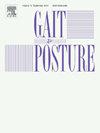Use of Gait Profile Score and Gait Variable Score to quantify patient improvement immediately following neuro-orthopedic surgery in patients with cerebral palsy – A prospective cohort study
IF 2.2
3区 医学
Q3 NEUROSCIENCES
引用次数: 0
Abstract
Background
The Gait Profile Score (GPS) and the Gait Variable Score (GVS) are summary measures used to assess the long-term effects of neuro-orthopedic surgery (NOS) in children with cerebral palsy (cwCP).
Research question
What are the immediate changes after NOS as assessed by GPS and GVS, and how does GPS variation (ΔGPS) compare to the clinical opinion of the NOS outcome?
Methods
Prospective single-arm cohort study. CwCP were assessed before NOS and after the first month of weight-bearing. Popliteal angle, ankle passive dorsiflexion (pDF), and spasticity were collected at the bedside. During walking, pain was assessed using NPRS, and speed was obtained from gait analysis data, as well as GPS and GVS. Longitudinal variations were analyzed using the Wilcoxon test. Children were classified as Improved (I), Stable (S), or Worsened (W) according to ΔGPS and the cut-off threshold recommended in literature. Two clinicians independently classified patients either as I, S, or W based on surgical outcome. Agreement between these two classifications was analyzed using Cohen’s k.
Results
Twenty cwCP, 11.4 (3.4) years, were included. At the follow-up: the popliteal angle was reduced by 20° (p=0.015); pDF increased by 10° (p<0.001), and triceps surae spasticity decreased (p=0.008). Pain decreased in four children. GPS decreased from 12.7 (range 8.1–27.7) to 11.8 (7.6–17.6) (ES=0.514, p=0.046), despite a decrease in gait speed (p<0.001). GVS better highlighted the effect of NOS after single-level surgery. Clinically, 18/1/1 children were classified I/S/W. Based on ΔGPS, 9/8/3 children were classified I/S/W. Such disagreement (k=0.119, p=0.227) was mainly due to the different focus of the two assessments.
Significance
Following NOS, immediate improvements in walking kinematics were observed.
使用步态轮廓评分和步态变量评分量化脑瘫患者神经矫形手术后的即时改善情况 - 一项前瞻性队列研究
背景步态轮廓评分(GPS)和步态变量评分(GVS)是用于评估神经矫形手术(NOS)对脑瘫患儿(cwCP)长期影响的概括性指标。研究问题通过GPS和GVS评估NOS后的直接变化是什么,GPS变化(ΔGPS)与NOS结果的临床意见相比如何?在 NOS 前和负重一个月后对 CwCP 进行评估。在床边收集腘窝角、踝关节被动外展(pDF)和痉挛情况。在行走过程中,使用 NPRS 对疼痛进行评估,根据步态分析数据以及 GPS 和 GVS 获取速度。纵向变化采用 Wilcoxon 检验进行分析。根据ΔGPS和文献推荐的临界值,儿童被分为病情好转(I)、病情稳定(S)和病情恶化(W)。两名临床医生根据手术结果将患者独立分为 I、S 或 W。使用 Cohen's k 分析这两种分类之间的一致性。随访结果显示:腘绳肌角度缩小了20°(p=0.015);pDF增加了10°(p<0.001),肱三头肌痉挛减轻(p=0.008)。四名儿童的疼痛减轻。尽管步速有所下降(p<0.001),但GPS从12.7(范围8.1-27.7)下降到11.8(7.6-17.6)(ES=0.514,p=0.046)。GVS更能突出单层手术后NOS的效果。临床上,18/1/1 名患儿被归类为 I/S/W。根据ΔGPS,9/8/3 名患儿被归类为 I/S/W。这种分歧(k=0.119,p=0.227)主要是由于两种评估的侧重点不同。
本文章由计算机程序翻译,如有差异,请以英文原文为准。
求助全文
约1分钟内获得全文
求助全文
来源期刊

Gait & posture
医学-神经科学
CiteScore
4.70
自引率
12.50%
发文量
616
审稿时长
6 months
期刊介绍:
Gait & Posture is a vehicle for the publication of up-to-date basic and clinical research on all aspects of locomotion and balance.
The topics covered include: Techniques for the measurement of gait and posture, and the standardization of results presentation; Studies of normal and pathological gait; Treatment of gait and postural abnormalities; Biomechanical and theoretical approaches to gait and posture; Mathematical models of joint and muscle mechanics; Neurological and musculoskeletal function in gait and posture; The evolution of upright posture and bipedal locomotion; Adaptations of carrying loads, walking on uneven surfaces, climbing stairs etc; spinal biomechanics only if they are directly related to gait and/or posture and are of general interest to our readers; The effect of aging and development on gait and posture; Psychological and cultural aspects of gait; Patient education.
 求助内容:
求助内容: 应助结果提醒方式:
应助结果提醒方式:


